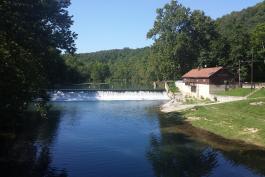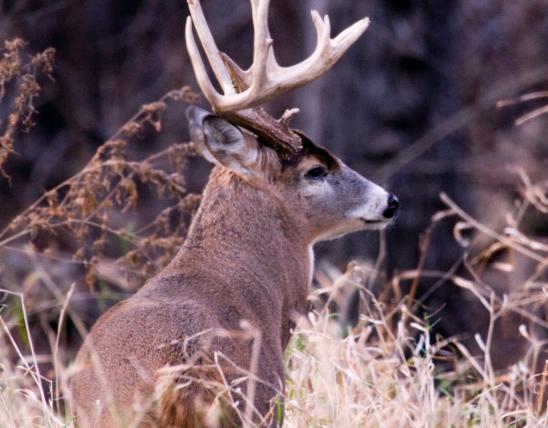
Around 1900 the Neosho National Fish Hatchery stocked Bennett Spring with rainbow trout. This stocking proved to be so popular with customers that a hatchery was built to maintain the fishery. The goal of providing a quality outdoor experience for customers was the driving force then, just as it is today. The hatchery, operated by the Missouri Department of Conservation, now provides approximately 400,000 rainbow trout to anglers each year. These fish are stocked from March through October on a nightly basis in Bennett Spring State Park. A small number of brown trout are also stocked. Downstream, the Niangua River also receives monthly commitments of trout year-round.
The hatchery can be accessed by driving west on Highway 64 approximately 12 miles from Lebanon, Missouri. Visitors can enjoy the natural beauty and many outdoor activities today just as they did at the turn of the last century.
- Sunday, 04:00 AM - 10:00 PM
- Monday, Tuesday, Wednesday, Thursday, Friday, Saturday, 04:00 AM - 10:00 PM
Area Regulations
4701 - 3CSR 10-11 - 105 Title; Authority
Chapter 11 of the Wildlife Code applies to this area. The information provided reflects regulations for most activities on this conservation area but does not contain regulations for all possible uses. For more information on area regulations consult the Wildlife Code or call the phone number listed for the area in the area details section.
4701 - 3CSR 10-11 - 110 General Provisions
Department areas designated as open to the public may be accessed and used for hiking; sightseeing; nature observation; entering or remaining on designated portions of department areas; possession of pets and hunting dogs; field trials; use of vehicles, bicycles, horses, and horseback riding; collecting of nuts, berries, fruits, edible wild greens, and mushrooms; camping; tree stands; target shooting and use of shooting ranges; decoys and blinds; use of boats and motors; taking bullfrogs and green frogs; hunting; trapping; and fishing. The locations and times when department areas may be entered, remained on, or used for these activities may be further restricted by Chapter 11 of the Wildlife Code, signs, this conservation atlas, or area maps. In addition to the rules of the Wildlife Code, federal, state and local laws apply on department lands.
The following activities are prohibited on department areas and may not be authorized by a special use permit:
1. Destruction, defacing, or removal of department property
2. Digging or excavating
3. Guiding for pay
4. Military or law enforcement training by nongovernment entities
5. Placing of grain, salt products, minerals, and other consumable products on land
6. Placing or using trail or game cameras or other similar devices
7. Use of paint ball, airsoft, or similar projectile weapons not specifically authorized by this Code
8. Placement of honey bee apiaries
9. Parking or storage of watercraft and commercial vehicles during closed hours
10. Use of fireworks
11. Use of remote-controlled boats or land vehicles
12. Prospecting, exploring, mining, or extracting minerals, metals, oil, natural gas, or other nonrenewable resources, except as specifically approved by the commission
13. Commercial or political advertising, except for commercial advertising by authorized concessionaires or by vendors participating in department events
Other activities not listed above, including commercial use and vending, may be authorized by a special use permit when the activity is compatible with other authorized activities. Special use permits may be issued only by the area manager or their designee. Issuance of a special use permit is at the discretion of the department. Application for a special use permit does not guarantee that one will be issued.
Signs, posted regulations, or area maps may further restrict activities, including designating portions of department areas as open or closed to public use. Department areas or designated portions of department areas may be closed, or regulations may be changed, through posting to protect the public from hazardous conditions and threats to public safety, to protect fish and wildlife resources, and for special events or resource management activities where public use conflicts are likely to occur. All persons entering, remaining on, or using a department area shall abide by signs, posted regulations, and area maps.
Waste containers located on department areas may be used only for disposal of garbage, trash, refuse, or rubbish generated on the department area. NOTE: Waste containers are not provided on all department areas.
Collecting wild animals (including invertebrates) and their unprocessed parts is prohibited except under the provisions of a valid Wildlife Collector’s Permit, or as otherwise authorized in the Wildlife Code.
Collecting or possessing wild plants and their unprocessed parts is prohibited except by a Letter of Authorization for Plant Collecting, or as otherwise authorized in the Wildlife Code.
4701 - 3CSR 10-11 - 115 Closings
Special hours apply on this department area. This area is open to public use only as authorized by posting.
4701 - 3CSR 10-11 - 130 Vehicles, Bicycles, Horses, and Horseback Riding
State laws regarding the operation, registration and required equipment apply to the operation of motor vehicles on locations open to vehicular traffic on department areas. Vehicle use is restricted to graveled and paved roads and established parking areas, unless otherwise posted.
Except as otherwise posted, the speed limit on department areas is 45 miles per hour.
Unless otherwise posted, bicycles, including electric bicycles as defined in the Missouri Wildlife Code (Chapter 20- Definitions), are allowed on roads open to vehicular traffic and service roads (designated in the online conservation atlas). Bicycles must stay on roads open to vehicular traffic or service roads, or on multi-use trails posted as open to bicycles. Bicycle use is not allowed on service roads passing through designated natural areas (designated in the online conservation atlas). Groups of 10 or more people using bicycles on a department area must obtain a special use permit. Special use permits should be requested at least 30 days in advance at: SpecialUsePermit.
4701 - 3CSR 10-12 - 150 Fishing, Trout Parks
No person shall continue to fish for any species of fish in the Trout Park after having 4 trout in possession.
4701 - 3CSR 10-11 - 120 Pets and Hunting Dogs
4701 - 3CSR 10-12 - 150 Fishing, Trout Parks
No person shall continue to fish for any species of fish in the Trout Park after having 4 trout in possession.
4701 - 3CSR 10-11 - 187 Trapping
4701 - 3CSR 10-20 - 805 Definitions
Flies, lures, and baits: The following are authorized for use except where restricted in 3 CSR 10-6.415, 3 CSR 10-6.535, 3 CSR 10- 11.205, 3 CSR 10-12.135, and 3 CSR 10- 12.150. (A) Natural and scented baits—A natural fish food such as bait fish, crayfish, frogs permitted as bait, grubs, insects, larvae, worms, salmon eggs, cheese, corn, and other food substances not containing any ingredient to stupefy, injure, or kill fish. Does not include flies or artificial lures. Includes dough bait, putty or paste-type bait, any substance designed to attract fish by taste or smell, and any fly, lure, or bait containing or used with such substances. (B) Soft plastic bait (unscented)—Synthetic eggs, synthetic worms, synthetic grubs, and soft plastic lures. (C) Artificial lure—A lure constructed of any material excluding soft plastic bait and natural and scented bait as defined in (A) or (B) above. (D) Fly—An artificial lure constructed on a single-point hook, using any material except soft plastic bait and natural and scented bait as defined in (A) or (B) above, that is tied, glued, or otherwise permanently attached.
Seasonal Hunting and Fishing Information
Trout (Statewide Seasons and Limits)
No person shall continue to fish for any species of fish in the Trout Park after having 4 trout in possession.
All trout taken in a trout park must be included in the angler's statewide daily limit. The purchase of a daily trout fishing tag does not permit an angler to take additional trout in excess of the statewide daily limit.
Fishing is permitted only on designated waters during posted hours in Trout Parks.
During the catch and release season, fishing at Bennett Spring State Park, Montauk State park, and Roaring River State park is permitted only on Friday, Saturday, Sunday and Monday during designated hours.
Daily Limit: 4; Possession Limit: 8; Limits are a combination of brown trout and rainbow trout; Except,
All fish must be returned to the water unharmed immediately after being caught during the Catch and Release Season in trout parks (Bennett Spring State Park, Montauk State Park, Maramec Spring Park, and Roaring River State Park).
Length Limits: No length limits, except:
All brown trout less than 15 inches in total length must be released unharmed immediately after being caught on streams.
Things to Do When You Visit
Fishing
Trout
Tours



























